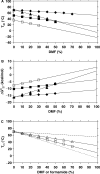On the stability of peptide nucleic acid duplexes in the presence of organic solvents
- PMID: 17478520
- PMCID: PMC1904262
- DOI: 10.1093/nar/gkm210
On the stability of peptide nucleic acid duplexes in the presence of organic solvents
Abstract
Nucleic acid double helices are stabilized by hydrogen bonding and stacking forces (a combination of hydrophobic, dispersive and electrostatic forces) of the base pairs in the helix. One would predict the hydrogen bonding contributions to increase and the stacking contributions to decrease as the water activity in the medium decreases. Study of nucleobase paired duplexes in the absence of water and ultimately in pure aprotic, non-polar organic solvents is not possible with natural phosphodiester nucleic acids due to the ionic phosphate groups and the associated cations, but could be possible with non-ionic nucleic acid analogues or mimics such as peptide nucleic acids. We now report that peptide nucleic acid (PNA) (in contrast to DNA) duplexes show almost unaffected stability in up to 70% dimethylformamide (DMF) or dioxane, and extrapolation of the data to conditions of 100% organic solvents indicates only minor (or no) destabilization of the PNA duplexes. Our data indicate that stacking forces contribute little if at all to the duplex stability under these conditions. The differences in behaviour between the PNA and the DNA duplexes are attributed to the differences in hydration and counter ion release rather than to the differences in nucleobase interaction. These results support the possibility of having stable nucleobase paired double helices in organic solvents.
Figures




Similar articles
-
Hydrogen bonding versus stacking stabilization by modified nucleobases incorporated in PNA.DNA duplexes.Biophys Chem. 2009 Apr;141(1):29-33. doi: 10.1016/j.bpc.2008.12.006. Epub 2008 Dec 31. Biophys Chem. 2009. PMID: 19162391
-
Microcalorimetry and fluorescence show stable peptide nucleic acid (PNA) duplexes in high organic content solvent mixtures.Org Biomol Chem. 2019 Aug 28;17(34):7874-7877. doi: 10.1039/c9ob01460h. Org Biomol Chem. 2019. PMID: 31424467
-
Stabilization factors affecting duplex formation of peptide nucleic acid with DNA.Biochemistry. 2001 Jul 24;40(29):8444-51. doi: 10.1021/bi010480m. Biochemistry. 2001. PMID: 11456481
-
Nucleobase modifications in peptide nucleic acids.Curr Top Med Chem. 2007;7(7):667-79. doi: 10.2174/156802607780487795. Curr Top Med Chem. 2007. PMID: 17430208 Review.
-
Replacement of Less-Preferred Dipolar Aprotic and Ethereal Solvents in Synthetic Organic Chemistry with More Sustainable Alternatives.Chem Rev. 2022 Mar 23;122(6):6749-6794. doi: 10.1021/acs.chemrev.1c00672. Epub 2022 Feb 24. Chem Rev. 2022. PMID: 35201751 Free PMC article. Review.
Cited by
-
Responsive Nucleic Acid-Based Organosilica Nanoparticles.J Am Chem Soc. 2023 Oct 25;145(42):22896-22902. doi: 10.1021/jacs.3c00393. Epub 2023 Sep 21. J Am Chem Soc. 2023. PMID: 37734737 Free PMC article.
-
Molecular computing by PNA:PNA duplex formation.Artif DNA PNA XNA. 2011 Jan;2(1):16-22. doi: 10.4161/adna.2.1.15459. Artif DNA PNA XNA. 2011. PMID: 21686248 Free PMC article.
-
Synthesis and structure-activity relationship of peptide nucleic acid probes with improved interstrand-crosslinking abilities: application to biotin-mediated RNA-pulldown.RSC Chem Biol. 2022 Jul 21;3(9):1129-1143. doi: 10.1039/d2cb00095d. eCollection 2022 Aug 31. RSC Chem Biol. 2022. PMID: 36128507 Free PMC article.
-
Nucleic Acid Identity, Structure, and Flexibility Affect the Electrochemical Signal of Tethered Redox Molecules upon Biopolymer Collapse.Langmuir. 2021 Oct 26;37(42):12466-12475. doi: 10.1021/acs.langmuir.1c02161. Epub 2021 Oct 13. Langmuir. 2021. PMID: 34644498 Free PMC article.
-
Comparative genome-wide analysis of small RNAs of major Gram-positive pathogens: from identification to application.Microb Biotechnol. 2010 Nov;3(6):658-76. doi: 10.1111/j.1751-7915.2010.00171.x. Microb Biotechnol. 2010. PMID: 21255362 Free PMC article. Review.
References
-
- Watson JD, Crick FH. Genetical implications of the structure of deoxyribonucleic acid. Nature. 1953;171:964–967. - PubMed
-
- Saenger W. Principles of Nucleic acid Structure. New York: Springer; 1988.
-
- Kool ET. Hydrogen bonding, base stacking, and steric effects in DNA replication. Annu. Rev. Biophys. Biomol. Struct. 2001;30:1–22. - PubMed
-
- Oostenbrink C, van Gunsteren WF. Efficient calculation of many stacking and pairing free energies in DNA from a few molecular dynamics simulations. Chemistry. 2005;11:4340–4348. - PubMed
-
- Sundaralingam M, Ponnuswamy PK. Stability of DNA duplexes with Watson–Crick base pairs: a predicted model. Biochemistry. 2004;43:16467–16476. - PubMed
Publication types
MeSH terms
Substances
LinkOut - more resources
Full Text Sources
Other Literature Sources

